#Hilyard M. Brown
Text

Robert Mitchum in The Night of the Hunter (Charles Laughton, 1955)
Cast: Robert Mitchum, Lillian Gish, Shelley Winters, James Gleason, Evelyn Varden, Peter Graves, Don Beddoe, Billy Chapin, Sally Jane Bruce, Gloria Castillo. Screenplay: James Age, based on a novel by Davis Grubb. Cinematography: Stanley Cortez. Art direction: Hilyard M. Brown. Film editing: Robert Golden. Music: Walter Schumann.
Is there another great film so inconsistent in tone and technique? For The Night of the Hunter is a great film for the most part -- certainly every part that features Robert Mitchum in one of the defining roles of his career. And the central section that deals with the river journey of the two children, John (Billy Chapin) and Pearl Harper (Sally Jane Bruce), has a mythic resonance, enhanced by Lillian Gish's marvelously naive retelling of the stories of Moses in the bulrushes and the flight of the Holy Family from Herod's massacre of the innocents. Director Charles Laughton, cinematographer Stanley Cortez, and art director Hilyard M. Brown give us memorable images like that of the drowned Shelley Winters, hair floating like the underwater weeds, or the one of Mitchum on horseback silhouetted in the distance against the night sky as the terrified children cower in a barn. I particularly love one heart-stopping moment: Lillian Gish has been sitting on her screened porch, shotgun on her lap, protecting the children while Mitchum waits outside. Gish and Mitchum have both been singing the hymn "Leaning on the Everlasting Arms" in an ironically peaceful duet. Then a child brings a candle to the porch and its light is reflected on the screen for a moment, hiding Mitchum from Gish's view. She quickly blows out the candle, but by the time she does, he has disappeared. If Laughton had been able to sustain this sort of tension throughout the film, it would be easier to call The Night of the Hunter a masterpiece. But some of his work is undone by the intrusive score by Walter Schumann. And Laughton, in his only film as director, isn't able to bring off what should be the film's climax: the capture, trial, and threatened lynching of Mitchum's character. As staged and edited, it proves anticlimactic. Nor does the Christmasy happy ending succeed in avoiding sentimentality. Some of the film's flaws no doubt result from the screenplay by James Agee, much revised by Laughton, which occasionally works too hard at being "poetic." But it's criminal that the poor initial reception of the film discouraged Laughton from trying his hand as director again.
3 notes
·
View notes
Photo

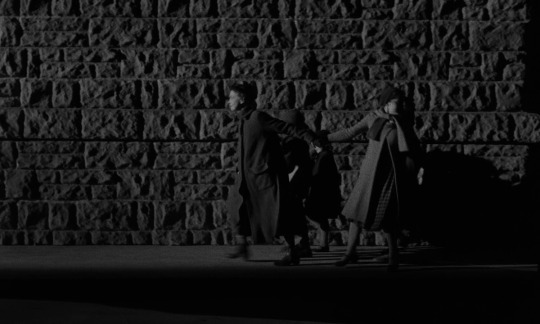








“It’s a hard world for little things.”
The Night of the Hunter, 1955.
Dir. Charles Laughton | Writ. James Agee | DOP Stanley Cortez | Art Dir. Hilyard M. Brown
28 notes
·
View notes
Photo










Valley of the Zombies (Philip Ford, 1946).
#valley of the zombies#valley of the zombies (1946)#philip ford#robert livingston#charles trowbridge#reggie lanning#william p. thompson#hilyard m. brown#allen alperin#john mccarthy jr.
25 notes
·
View notes
Photo
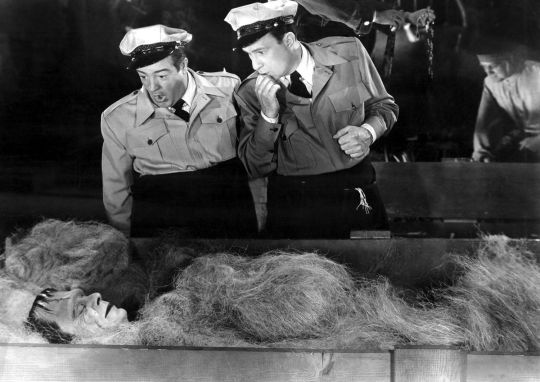
Abbott and Costello Meet Frankenstein (1948)
Universal Pictures was, for the most part, not considered a major studio when it released its first horror films in the early synchronized sound era. Its line of classic monsters includes The Phantom of the Opera (1925), Dracula (1931), Frankenstein (1931), The Mummy (1932), and others. Horror, seen as a popular (but lesser) genre in American filmmaking at the time, burnished Universal’s reputation through the 1930s and ‘40s. But despite the commercial success of so many of the Universal Monsters movies (not considered a franchise until the 1960s and ‘70s), the studio still did not command the resources of a Paramount or a Metro-Goldwyn-Mayer (MGM). Unlike Hollywood’s biggest major studios, Universal did not have as many contracted craftspersons and actors in its ranks. As such, the studio often had to rely on its rivals loaning talent out to them. Universal, more than any other studio, leaned on actors at the time better known for their radio work. Among those radio stalwarts were Bud Abbott and Lou Costello, whose “Who’s on First?” routine remains widely-referenced.
By the mid-1940s, Universal’s stable of monsters was well-known to the general American moviegoing public. Many of those monsters – Frankenstein’s monster especially – had appeared in various sequels over the years, to decreased budgets and diminishing returns on audience frights. In an attempt to rejuvenate this then-unofficial series of movies, Universal hatched the idea to put their leading comedy duo and many of their monsters in the same film. To some at the time, the very idea of pairing Bela Lugosi’s Dracula with Abbott and Costello was the death knell for Universal’s monsters. Instead, Abbott and Costello Meets Frankenstein, though chaotic in terms of plot, is a first-rate comedy. It is perhaps the best movie made featuring Abbott and Costello. However, the film’s naysayers are partly correct – this is the beginning of the end of Universal’s classic horror movies. And for those who have been able to see each of the original Universal Monsters movies prior to this, this is a hilarious way to cap off a journey into the most iconic horror movies of Golden Age Hollywood.
One evening, Larry Talbot (Lon Chaney Jr.) telephones a train station in La Mirada, Florida, warning of two packages addressed for McDougal’s House of Horrors (a wax museum) that must not reach their destination. But just as Larry is about to complete his thoughts, the moon rises, and he transforms into The Wolf Man. Without that critical information, baggage clerks Chick Young (Abbott) and Wilbur Grey (Costello) make the deliveries. As they crack open the crates, they realize that they are delivering Dracula’s (Bela Lugosi; this is not Lugosi’s final role as a vampire, but it is his final go-around as Dracula in a movie) coffin and Frankenstein’s monster (Glenn Strange; Boris Karloff refused to appear in this film). With a cast of characters also including Mr. McDougal (Frank Ferguson), Dr. Sandra Mornay (Lenore Aubert), and an undercover insurance investigator named Joan Raymond (Jane Randolph), the so-called plot bounces around a number of horror hijinks that center on Dracula attempting to provide Frankenstein’s monster a more intelligent and obedient brain.
The film’s opening credits and its seamless vampire bat transformation sequences were animated by Walter Lantz, best known as the creator of Woody Woodpecker and the original voice actor for Oswald the Lucky Rabbit. Vincent Price has a voice acting cameo, years before his association with the horror genre.
For almost the entirety of Abbott and Costello Meet Frankenstein, the film depends on the shtick that defines the titular duo. This is an Abbott and Costello movie first, a Universal Classic Monsters movie second. Where Costello is the prone-to-face-scrunching, excitable, and more easily-frightened of the two, Abbott is the straight man with the composure in the hairiest of situations. And this shtick – which I admit never sounds appealing when reading it, so it is best to view it for yourself – does not overstay its welcome. It is most effective in the scenes immediately after revealing Dracula’s coffin and the monster’s boxes and when our beleaguered baggage clerks (there is an incredible joke about unions that I do not wish to spoil for first-time viewers) meet Larry Talbot, in-person, for the first time. As messy as this movie can be in spurts (it feels as if there were several ideas cross-stitched together in hopes of forming a coherent whole), Abbott and Costello’s brand of humor fits neatly in this film. Their comedic dynamic feels natural in a world where heavily-accented, cape-wearing vampires and reluctant werewolves exist – let alone humans who might want to profit off the actions of these monsters or ride the coattails of Dracula’s machinations.
Of all the other actors not named Abbott and Costello, it is Lugosi who makes the most of his time here, even with material that is not as demanding as he may have wanted. By this time in his career and almost twenty years removed from Dracula, Lugosi was the victim of serial typecasting while contracted to Universal. The Hungarian-American actor, in his listing in the Academy of Motion Pictures Arts and Sciences’ Players Directory, requested Hollywood’s casting directors not to think of him only for horror movies. And yet, he frequently found himself cast for horror movies – usually second billing behind Englishman Boris Karloff. Once more, for Abbott and Costello Meet Frankenstein, Lugosi was in overly familiar territory – but at least this was a send-up of the horror tropes that he must have been too familiar with by then. But no one, past or present, could ever be as charismatic in a cape and stare, menacingly, at someone’s neck. Lugosi, who was not as fluent in English when he made the original Dracula, has less, but more complex dialogue for Abbott and Costello Meet Frankenstein. He nevertheless delivers it with aplomb, including his delightful dramatic pauses he occasionally inserts (“What we need is young blood – and brains.”) Lugosi might have been annoyed in starring in yet another Universal horror movie, but he never shows it here in what was his final “A”-picture (and before his association with low-budget filmmaker Ed Wood).
As a part-horror movie, Abbott and Costello Meet Frankenstein’s favoring of the comedic duo over any of the monsters will likely irritate fans of the Universal Classic Monsters series. But I do not think imbalance of screentime is the problem (which I will elaborate on shortly). Though longtime Abbot and Costello writer John Grant’s (1941’s Buck Privates, 1945’s The Naughty Nineties) screenplay grants considerable authority to Dracula, one cannot say the same for Frankenstein’s monster and The Wolf Man. After the opening scene of the film, Lon Chaney Jr. never again appears as if he is committing himself fully to playing Larry. Glenn Strange’s turn as Frankenstein’s monster, too, feels far too labored a performance (and a performance that is never given enough attention in this film). This monster mash, on paper, should be a graveyard smash. But by film’s end, the screenplay has not done Frankenstein’s monster or The Wolf Man the narrative justice that both characters deserve, given the legacies they have at Universal.
This imbalance is of no fault of the comedic aspects of Abbott and Costello Meet Frankenstein, or of Abbott and Costello themselves. Horror and comedy are not oil and water. The two can absolutely mix, as seen in Young Frankenstein (1974) and Tremors (1990) – in these examples (among many others), the comedy does not interfere in the gravity of the horror, and the horror elements do not detract from the audience’s laughter. For director Charles Barton (the principal Abbott and Costello director from 1946 on, 1959’s The Shaggy Dog) and John Grant, the film’s most glaring problem is their unwillingness to use their monsters’ hallmarks and their lack of trust in the monsters’ stage presence until the film’s unexpectedly gruesome finish. As such, despite some fascinating, atmospheric art direction by Hilyard M. Brown (1954’s Creature from the Black Lagoon, 1963’s Cleopatra) and Bernard Herzbrun (1938’s Alexander’s Ragtime Band, Creature from the Black Lagoon), this film sags in its appeal as a piece of horror. As a comedy, Abbott and Costello Meet Frankenstein might just be the most effective use of the comedic duo in any movie. The film is deserving of its comedic reputation from the first minutes, as we find Bud and Lou at the height of their comedic prowess. But, as a send-off for the horror characters and the actors that portrayed them, there might be a bitter taste for the most ardent fans of Frankenstein’s monster, Dracula, and The Wolf Man.
During the filming of Abbott and Costello Meet Frankenstein, practical jokes ran rampant on the set. On a set with Abbott and Costello, once has to expect daily mischief. And for this production, that meant exploding cigars, pie fights, and frequent ad-libbing to throw off other actors. According to Barton, “Bela [Lugosi] of course would have nothing to do with any of this. He would just glare at those involved with his famous deadly stare and the only emotion he would show physically was one of utter disgust.” Lugosi, by all accounts, never reacted to any of Abbott and Costello’s off-camera tomfoolery, and committed to delivering the best work possible. One of the most iconic figures of Hollywood horror movies was not going to blemish his reputation here.
By 1948, horror movies at Universal Pictures had mostly run their course during the age of the Studio System. Universal would not release another monster horror film until Creature from the Black Lagoon (1954). Within a few years, Universal would abandon its line of monster horror movies entirely. By then, a plucky studio in London was beginning to make its own monster horror movies, often using the characters that Universal had adapted and codified for audiences in the 1930s and ‘40s. For boasting such an influential run of horror movies, Universal did not truly treasure what incredible talent it fostered until decades after Abbott and Costello Meet Frankenstein. No one in the year of the film’s release might have predicted the cultural cachet that Abbott and Costello Meet Frankenstein eventually found as a horror comedy film. The film was inducted into the Library of Congress’ National Film Registry in 2001, and remains one of the most highly-regarded comedies in American moviemaking.
My rating: 8/10
^ Based on my personal imdb rating. My interpretation of that ratings system can be found in the “Ratings system” page on my blog (as of July 1, 2020, tumblr is not permitting certain posts with links to appear on tag pages, so I cannot provide the URL).
For more of my reviews tagged “My Movie Odyssey”, check out the tag of the same name on my blog.
#Abbott and Costello Meet Frankenstein#Abbott and Costello#Charles Barton#Bud Abbott#Lou Costello#Lon Chaney Jr.#Bela Lugosi#Glenn Strange#Lenore Aubert#Jane Randolph#Vincent Price#John Grant#Robert Lees#Frederic I. Rinaldo#Hilyard M. Brown#Bernard Herzbrun#Walter Lantz#TCM#My Movie Odyssey
18 notes
·
View notes
Photo
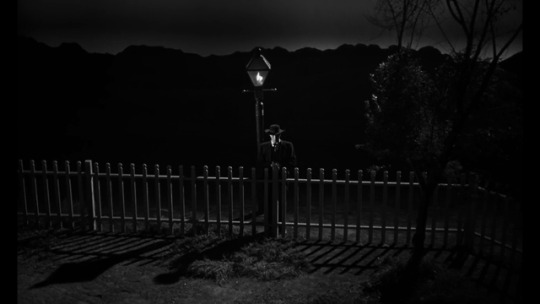

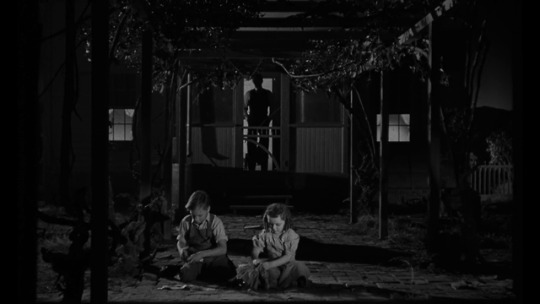

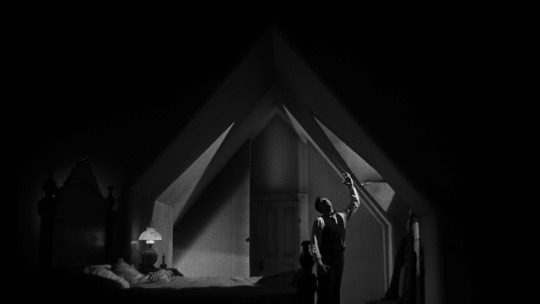



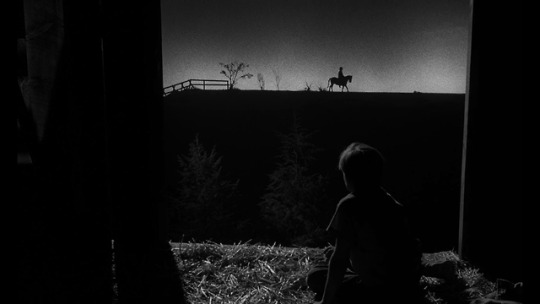
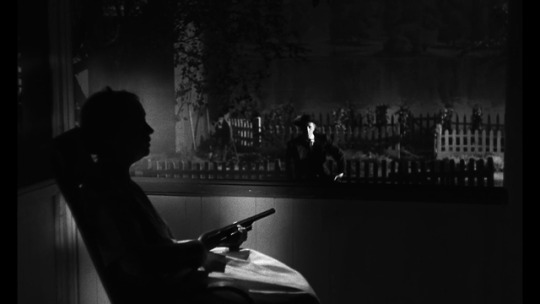
The Night of the Hunter (1955)
Country: United States
Directed by: Charles Laughton
Written by: Laughton (uncredited) & James Agee
Based on the novel by: Davis Grubb
Cinematography by: Stanley Cortez
Edited by: Robert Golden
Produced by: Paul Gregory
Music by: Walter Schumann
Art Direction by: Hilyard M. Brown
#The Night of the Hunter#Movie#United States#Charles Laughton#James Agee#Davis Grubb#Stanley Cortez#Robert Golden#Paul Gregory#Walter Schumann#Hilyard M. Brown#The Criterion Collection#United Artists#MGM Home Entertainment#20th Century Fox#1950s#Film-Noir#Crime#Thriller#Horror#Drama#Expressionism
2 notes
·
View notes
Text
Referências Cinematográficas

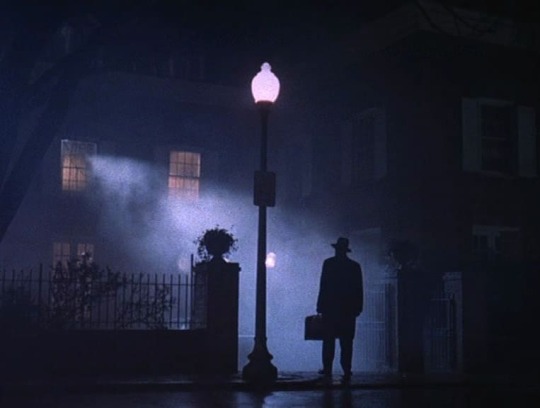
The Night of the Hunter
Director: Charles Laughton
Director of Photography: Stanley Cortez
Production Design: Hilyard M. Brown
Year: 1955
The Exorcist
Director: William Friedkin
Director of Photography: Owen Roizman
Production Design: Bill Malley
Costume Design: Joseph Fretwell III
Year: 1973
#the night of the hunter#charles laughton#the exorcist#william friedkin#o mensageiro do diabo#o exorcista
4 notes
·
View notes
Text
Academy Award For Best Production Design: Ranked 10 Winners
Ranked ten winners of Academy award for best production design!!
First and foremost, a production design is all things that go into creating the world in a film. That might include sets, props, and more.
Regardless of the importance of ‘production design’ in filmmaking, several audiences are still unaware of its existence and take it for granted.
Prior to ranking the winners of the Academy Award for Best Production Design, let the wind out of sails over a short history of the award itself.
Correspondingly, the Academy Award for Best Production Design was initially referred to as the Academy Award for Art Direction.
Also, the award was designated to the best monochrome ( black and white) cinema and the best color cinema every year.
Eventually, the Academy decided to merge set decoration with art direction in 1947.
Nevertheless, the award leads the change to Best Production Design.
Here, we have built a quick run-through so that you can check with ease when in need of creative inspiration. Feel free to check this one out.
1. Doctor Zhivago
Year: 1977
Art Directors: John Box, Terence Marsh
Set Decorators: Dario Simoni
Without a doubt, period piece films have better luck of getting the Academy Award for Best Production Design than non-period piece film does.
2. Spartacus
Year: 1960
Art Directors: Alexander Golitzin, Eric Orbom
Set Decorators: Russell A. Gausman, Julia Heron
Undoubtedly, one of the deserving winners of the Academy Award for Best Production Design is Stanley Kubrick’s film, Spartacus.
Likewise, none of the similar pictures like A Clockwork Orange, 2001: A Space Odyssey, or Eyes Wide Shut had won the Oscar. But Spartacus won it way ahead of time.Spartacus
Year: 1960
Art Directors: Alexander Golitzin, Eric Orbom
Set Decorators: Russell A. Gausman, Julia Heron
Undoubtedly, one of the deserving winners of the Academy Award for Best Production Design is Stanley Kubrick’s film, Spartacus.
Likewise, none of the similar pictures like A Clockwork Orange, 2001: A Space Odyssey, or Eyes Wide Shut had won the Oscar. But Spartacus won it way ahead of time.
3. Mad Max: Fury Road
Year: 2015
Production Designer: Colin Gibson
Set Decorators: Lisa Thompson
If someone took a desert dust bowl and transformed it into an apocalyptic playground for twenty-foot huge cars, then the picture could quite look like Mad Max: Fury Road.
4. Cleopatra
Year: 1963
Art Directors: John Decuir, Eleven Webb, Jack Martin Smith, Maurice Pelling, Hilyard M. Brown, Boris Juraga
Set Decorators: Walter M. Scott, Ray Moyer, Paul S. Fox
Another winner, Cleopatra, clearly gives an overall view that today moviemakers do not make film sets like they used to. Undoubtedly, CGI sets have changed the way of moviemaking for big-name studios.
Cleopatra won the Academy Award for Best Production Design in 1963.
For more details click here
0 notes
Text
THE NIGHT OF THE HUNTER (1955) – Episode 114 – Decades of Horror: The Classic Era
"Ah, little lad, you're staring at my fingers. Would you like me to tell you the little story of right-hand/left-hand? The story of good and evil?" Do tell! Do tell! Join this episode’s Grue-Crew - Whitney Collazo, Chad Hunt, Daphne Monary-Ernsdorff, and Jeff Mohr, along with guest host Bill Gabriel - as they geek out on Lillian Gish’s, Shelley Winters’s, and Robert Mitchum’s performances in the only film directed by Charles Laughton, The Night of the Hunter (1955).
Decades of Horror: The Classic Era
Episode 114 – The Night of the Hunter (1955)
Join the Crew on the Gruesome Magazine YouTube channel!
Subscribe today! And click the alert to get notified of new content!
https://youtube.com/gruesomemagazine
ANNOUNCEMENT
Decades of Horror The Classic Era is partnering with THE CLASSIC SCI-FI MOVIE CHANNEL
which will now include video episodes of The Classic Era!
Available on Roku, AppleTV, Amazon FireTV, AndroidTV, Online Website.
Across All OTT platforms, as well as mobile, tablet, and desktop.
https://classicscifichannel.com/
A religious fanatic marries a gullible widow whose young children are reluctant to tell him where their real daddy hid the $10,000 he'd stolen in a robbery.
IMDb
Director: Charles Laughton
Writers: Davis Grubb (from the novel by); James Agee (screenplay by); Charles Laughton (screenplay contributor) (uncredited)
Cinematographer: Stanley Cortez
Music: Walter Schumann
Editor: Robert Golden
Art Direction: Hilyard M. Brown
Producer: Paul Gregory
Selected Cast
Robert Mitchum as Reverend Harry Powell
Shelley Winters as Willa Harper
Lillian Gish as Rachel Cooper
Billy Chapin as John Harper
Sally Jane Bruce as Pearl Harper
James Gleason as Uncle "Birdie" Steptoe
Evelyn Varden as Icey Spoon, Willa's employer
Don Beddoe as Walt Spoon, Icey's husband
Peter Graves as Ben Harper
Gloria Castillo as Ruby, one of Rachel's girls
Paul Bryar as Bart the Hangman
Cheryl Callaway as Mary (uncredited)
Mary Ellen Clemons as Clary (uncredited)
Michael Chapin as Ruby's Boyfriend (uncredited)
You’ll find no hate for The Night of the Hunter from the Classic Era Grue-Crew except on Chad’s fingers. This is Daphne’s pick and she loves The Night of the Hunter, calling it a beautiful piece of art. For Bill, the film has been in his DNA as far back as he can remember. He was scared out of his wits by Mitchum’s performance while other scenes were tear-inducing. Whitney sees the bond of siblings amidst the trauma the two children are dealing with in the real-life horror of The Night of the Hunter. This is one of Chad’s favorite films, referring to it as a beautiful, fairy tale of a movie with a dreamlike quality. He also tells a heartfelt story about watching The Night of the Hunter for the first time with his dad. Jeff found The Night of the Hunter to be a bit strange until he learned to view the exaggerations and eccentricities as seen through the eyes of young John. He now believes he must watch the movie much more often.
During the podcast, the Grue-Crew members refer several times to two videos. The first one is a 159-minute documentary, Charles Laughton Directs “The Night of the Hunter.” In the manner of silent film directors, Laughton almost never called “cut” to a scene, filming continuously through an entire reel while giving repeated direction to the actors to get the performance for which he was looking. IMDb describes the documentary as “an assembled compilation of footage from rushes, outtakes, and behind-the-scenes moments featuring Charles Laughton directing 'The Night of the Hunter.' The second video is a 5-minute video of Guillermo del Toro commenting on the importance to him of The Night of the Hunter. Links to the two videos are included below.
Charles Laughton Directs “The Night of the Hunter” (2002)
https://www.youtube.com/watch?v=TH6-t39B9Cg
Guillermo del Toro on The Night of the Hunter:
https://www.youtube.com/watch?v=wJ4xpKwvI60
At the time of this writing, The Night of the Hunter is available to stream from The Criterion Channel and various PPV services, and on physical media as a Criterion Blu-ray.
Gruesome Magazine’s Decades of Horror: The Classic Era records a new episode every two weeks. Up next on their very flexible schedule is one chosen by Whitney: Macario (1960), an acclaimed, Mexican, supernatural drama directed by Roberto Gavaldón. You will not want to miss that one!
Please let them know how they’re doing! They want to hear from you – the coolest, grooviest fans: leave them a message or leave a comment on the site or email the Decades of Horror: The Classic Era podcast hosts at [email protected]
To each of you from each of us, “Thank you so much for listening!”
Check out this episode!
0 notes
Link
0 notes
Photo







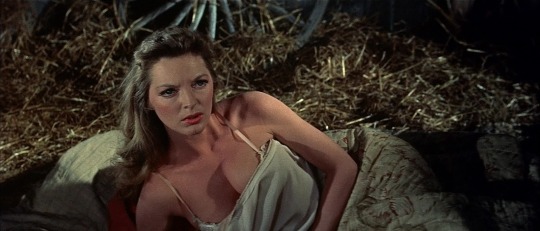


Man of the West (Anthony Mann, 1958)
Cast: Gary Cooper, Julie London, Lee J. Cobb, Arthur O’Connell, Jack Lord, Royal Dano, Robert J. Wilke. Screenplay: Reginald Rose, based on a novel by Will C. Brown. Cinematography: Ernest Haller. Art direction: Hilyard M. Brown. Film editing: Richard V. Heermance. Music: Leigh Harline.
That Gary Cooper is too old for his role and Lee J. Cobb too young for his doesn't detract much from this excellent Western. It's a treat to see the battle of acting styles between Cooper and Cobb. Cooper's still, centered performance, relying on the camera to catch the subtlety of his expressions, wins out over Cobb's Method-inspired scenery-chewing. It's fun, too, to see Jack ("Book ‘em, Danno”) Lord play the villain.
0 notes